The EAC’s “Clearie” Winners Ensure Accessible Elections
This story was featured in our ELECTricity newsletter in April 2019. Sign up to receive more success stories from election offices across the country. And how is your election office using technology to run excellent elections? Tell us about it by emailing [email protected] — we’d love to share your story!
In February, the Election Assistance Commission announced the recipients of the 2018 Clearies. Short for Clearinghouse Awards, the Clearies recognize best practices in election administration and celebrate outstanding work. This year the 3 award categories were accessibility, election innovation, and managing election workers.
There are 10 winners (5 counties, 2 cities, and 3 state offices). They are all worth checking out, but this Spotlight will focus on the accessibility category winners:
-
Martin County, Florida created videos explaining how to register and vote in American Sign Language
-
Contra Costa County, California empowered election workers to create and maintain accessible polling places
-
Iowa Secretary of State launched a vast statewide initiative to educate veterans and Iowans with disabilities about available resources
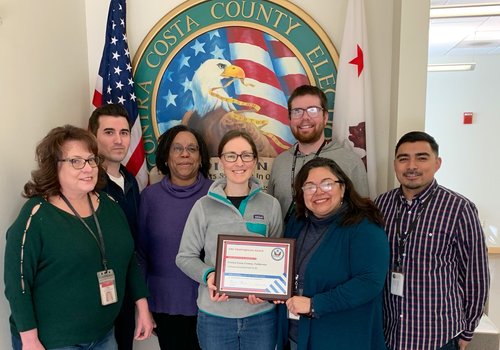
Some accessibility best practices, like using plain language and design, are universally helpful. Others are specific and targeted, like translating material into American Sign Language, because otherwise people get left behind. In 2012, a whopping 30% of voters with disabilities had difficulty voting (compared to 8% of voters without disabilities). Worse, people with disabilities are more likely to stay home. If people with disabilities voted at the same rate as people without disabilities, even controlling for demographic variables, there would have been 2.2 million more voters in 2016. And many explicitly cite their disability as the reason.
Thankfully, election administrators are both practical and creative, as the Clearies demonstrate. You partner with your community, you ask questions, you investigate. You brainstorm and you experiment. You’re always asking, “How can I make my elections better?”, and then you do.
Martin County, Florida Creates an Accessible Video Campaign
The Martin County Elections Center serves 114,356 active registered voters, and nearly 70% of them voted in the recent 2018 general election. Martin County received the Clearie Award for “Count Me in Too!”, an accessible video campaign that educates potential voters on how to register and vote. The information is presented in multiple formats: American Sign Language (ASL), audio voice-over, and close-captioning text.
“3 Ways to Vote” video with an ASL translation. Video courtesy of Martin County Election Center.
Since English and ASL are two completely different languages (with different syntax and grammar), people who know both are bilingual. Many ASL users are proficient in written English, but many read it like a second language, which can make technical voting jargon difficult to understand. So translating your election materials into ASL can reach voters who otherwise might struggle. As a bonus, the gesture shows the deaf and hard of hearing community that their votes matter too — a sentiment expressed in the name “Count Me in Too!”.
Kherri Anderson, the Deputy of Elections Outreach, says the idea originated during a community advisory board meeting in 2016. The board’s “resounding concern” was the lack of resources available to Martin County residents with disabilities. After double-checking with the other 66 Florida counties, they discovered nobody had yet created accessible videos explaining the voting process.
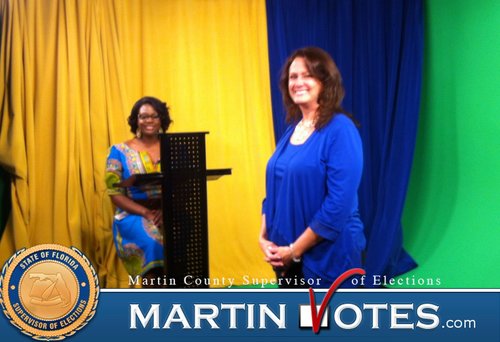
The Elections team partnered closely with the Deaf and Hard of Hearing Services of Treasure Coast to create English and ASL scripts for the video. They also partnered with MCTV, the television channel run by the Board of County Commissioners, who agreed to help at no cost. An ASL translator from the community (hired for $500) signed the videos, and Kherri read the English voice-over. “If you build partnerships with your local community and government partners, they are more than willing to help you,” Kherri says. “Our office is constantly in the community asking what we can do to serve them and because of that we have 100% of their support.”
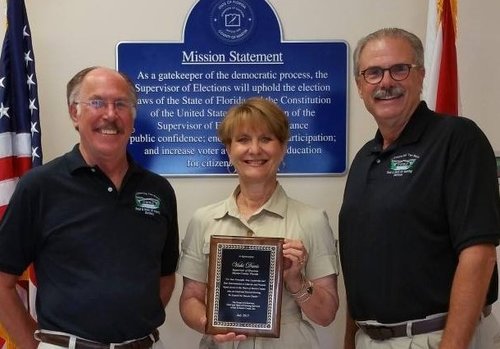
After creating the two videos (How to Register to Vote and 3 Ways to Vote), the Elections team hoped to see a 5% increase in turnout among voters with disabilities. The videos were published on the county website, on YouTube, on the Deaf and Hard of Hearing Services website, and were aired daily on MCTV. The actual results exceeded expectations — turnout increased by 8% among voters with disabilities! The Deaf and Hard of Hearing Services heard positive feedback from their consumers, and presented the county an award for the outreach program. “I love outreach,” Kherri says, “and we enjoy creating programs to help our voters be election ready!”
Contra Costa County, California Creates and Maintains Accessible Polling Places
Polling places are often physically inaccessible to voters with disabilities. During the 2016 election, the Government Accountability Office examined 178 polling places, and 60% had at least one potential impediment. The most common were:
-
Steep ramps or curb cuts
-
Entrance door thresholds over ½ inch high
-
Poor parking, pathway, or ramp surfaces
-
A lack of signage for accessible paths
Luckily most have temporary Election Day fixes, like blocking off hazards, using traffic cones to create accessible parking, and placing mats over broken pathways. But creating an accessible polling place is one thing, and maintaining it is another. Throughout Election Day, propped-open doors can close, traffic cones can shift, and rubber mats can fold. With hundreds of voters entering and exiting, polling places that are accessible in the morning can become inaccessible by the afternoon.
Contra Costa County, California, home to 631,040 registered voters, addresses this problem through exceptional poll worker training and management. The first APPLE classes (Accessible Polling Place Location and Equipment classes) were held in January 2018. The classes were immediately successful (and you may remember them from a previous electionline article and EAC blog). Essentially, the classes explain the importance of accessibility from the voter’s perspective. The classes focus less on technical procedures and more on the reasoning behind the procedures, so poll workers understand why accessibility is a priority.
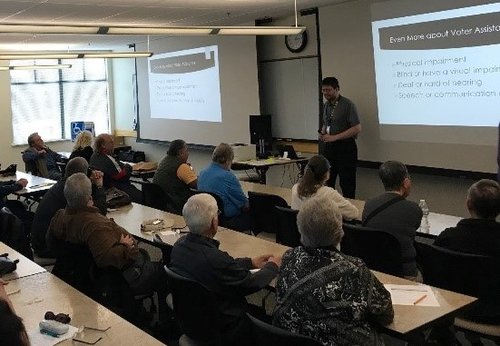
According to Sophie Lehman, the Election Services Manager, poll workers acted on their new knowledge in the June 2018 elections. “Among those who attended an APPLE class, 60% said they maintained the accessible path of travel and a quarter said they identified and corrected an issue. This was an incredible shift considering they had attended one class and this was the first election after that.”
Sophie says the “feedback made it clear poll workers were embracing their role in making their polling places accessible and we wanted to capitalize on this.” Normally, the Elections team handled the accessibility modifications, but seeing the enthusiasm of APPLE trainees, they felt ready to assign poll workers additional responsibilities. Contra Costa began brainstorming the Accessibility Kit program in July 2018, and rolled it out in November.
An Accessibility Kit was provided to every polling place, containing the equipment and instructions to set up and maintain the accessibility modifications. The Kits included an aerial map of the polling place (created by annotating Google Earth images), an overview of that location’s barriers and how to fix them, and generalized accessibility guides. The guides use simple instructions and images to help poll workers identify any new barriers and correct them.
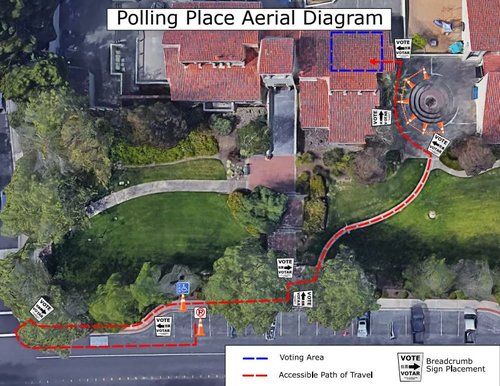
Sophie says there are many benefits to the Accessibility Kits. First, “instead of limiting knowledge and responsibility to just one of our staff members, we democratized the process and gave the knowledge and responsibility to all of the poll workers at each location.” This ensures that accessibility is vigilantly maintained throughout the day, not just in the morning. Second, the Elections team allocated human resources more efficiently, instead of making staff drive around the county setting up polling places. Third, once created, the Accessibility Kits can easily be updated and redeployed every election.
The APPLE classes and Accessibility kits go hand-in-hand, first arming poll workers with accessibility principles and then providing them with tools. “Making the kits was a lot of work on the front end,” Sophie says. “But for us, the payoff was well worth it. The upfront investment of time and resources ensured that Election Day was smooth.”
Iowa Secretary of State Educates Veterans and Iowans with Disabilities on Available Resources
No matter how accessible a polling place is, the perception of inaccessibility can keep people away. In a survey of people who hadn’t voted in-person in 10 years, 40% of respondents with disabilities expected to encounter difficulties at the polls, compared to 1% of respondents without disabilities.
Educational outreach isn’t easy. 90% of local election officials are like Kherri, and enjoy educating voters, but only 35% say they have enough time and resources to do it. So it’s a game-changer when outreach gets prioritized at the state level.
When Iowa Secretary of State Paul Pate took office in 2015, he launched a statewide outreach initiative for veterans and Iowans with disabilities. “The key is letting people know the resources that are available to them,” he explains. “Voting can be easy and accessible for someone with a disability, but we have to make sure they have the information available to them.”
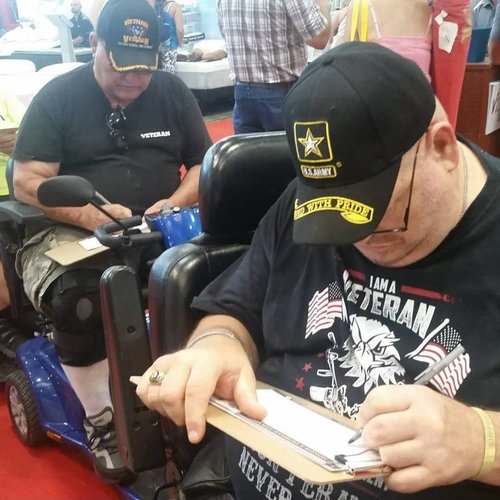
An estimated 300,000 Iowans of voting age have some type of disability, nearly 10% of the state’s population. Given the large overlap with military veterans, Secretary Pate strategically targeted outreach toward both groups. His office distributed tens of thousands of brochures, launched several Facebook Ad and Google Ad campaigns, and produced bipartisan videos explaining available resources. For each of these, two versions were created — one aimed at the general disabilities population, and one aimed at veterans. The office also hired an outreach coordinator and worked with veterans-affiliated groups and disability-affiliated groups.
Iowa partnered with the Iowa Developmental Disabilities Council to conduct workshops in 21 counties — and Secretary Pate intends to continue offering these as long as he’s in office. The informal workshops give Iowans with disabilities a chance to learn about resources and ask questions. “One of the best stories out of the workshops,” says Secretary Pate, was a veteran of 30 years. “He was 65 years old, had served our country honorably and defended our right to vote, but had never voted. Immediately after attending our workshop, he walked over to the county auditor’s office and voted for the first time in his life. That’s what this program is all about.”
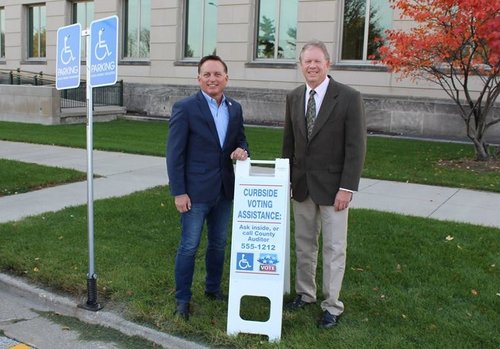
The office also reviewed accessibility aids for blind and vision-impaired Iowans, including an assessment of Braille polling place materials and their availability at every precinct. And since many use a screen reader to navigate websites, the online voter registration portal was updated to be screen reader-friendly — which is especially notable considering most states’ voter registration portals are not. Then, in partnership with the Iowa Council of the United Blind, Iowans with vision impairments were trained on accessible voting equipment ahead of Election Day to avoid any confusion around how to operate it.
To ensure an accessible Election Day, the state also worked closely with local election offices. “County auditors were very receptive to the initiative,” explains Secretary Pate, partially because “this made their jobs easier as well.” Tablets with the ADA Checklist for Polling Places were provided to all 99 counties, and curbside voting signs were distributed to all 1,700 polling places, and these resources were “very well received” by county auditors. The office also created several videos aimed at Election Day workers and voters. For Election Day workers, the videos demonstrate how to set up and operate accessible voting equipment. For voters, the videos demonstrate how to vote using that equipment.
Video demonstrating how to use an AutoMARK voting machine. Video courtesy of Iowa Secretary of State website.
One of the criteria for Clearie winners is replicability. Even though Iowa’s initiative is daunting in its entirety, Secretary Pate suggests that many of these actions “are things every state in the country can do.” Funding can be an obstacle, but elections offices don’t need to shoulder the entire cost burden themselves. For example, Disability Rights Iowa helped pay for the curbside voting signs. “There are organizations in every state that would be interested in partnering on a program like this.”
Additional Resources
If you’d like to launch an accessible video campaign, you can contact Kherri at [email protected] for advice. If you’re interested in accessibility classes for poll workers or Accessibility Kits, you can reach Sophie at [email protected]. And if you want information about any of Iowa’s trainings and outreach, contact the Iowa Secretary of State’s office.
The EAC provides many voting accessibility resources, as does the Center for Civic Design. The ADA Checklist for Polling Places is a good overview of physical polling place accessibility, as is Solutions for Five Common ADA Access Problems. If you would like to partner with disability groups, the National Disability Rights Network has a chapter in every state and is an excellent place to begin.
Finally, we offer a training on Accessible Communication for Election Offices which can be delivered in a 90-minute format or a 5-hour format, depending on your office’s needs. The training focuses on how people with disabilities experience election websites, social media, and other election materials.
How have you made your elections more accessible for voters with disabilities? Tell us about your experience by emailing [email protected].